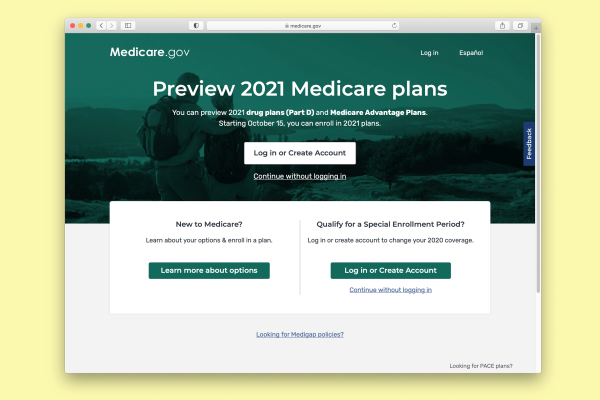Medicare Open Enrollment Starts Today, With New Insulin Coverage, Telehealth Benefits and More Changes

Medicare open enrollment arrives each fall as predictably as the foliage, accompanied by a barrage of TV ads that reminds you now’s the time for beneficiaries to pick new coverage for next year.
Open enrollment runs from Oct. 15 through Dec. 7. During this time, the more than 60 million Medicare beneficiaries can pick a new Medicare Part D drug plan, a new Medicare Advantage plan, or switch from original Medicare into a Medicare Advantage plan or vice versa. Any coverage changes made during this period will go into effect Jan. 1, 2021.
You're not required to act, but even if you like your current coverage it’s a good idea to make sure it still meets your needs. Plans are allowed to make changes to their list of participating doctors and their drug coverage. You’ll find any updates in your plan's annual “notice of change” that you should have received in the mail. You can search for all the plans available in your area at Medicare’s official Plan Finder tool.
Many of the Part D plans have agents and brokers who would typically visit senior centers and other community spots to talk to prospective customers during this season. Due to the pandemic, "a lot of that interaction may not happen this year,” says Corey Ford, director, reimbursement & policy insights at Xcenda, a health care consulting firm. The good news is you can still receive free, impartial, socially distant help in choosing plans through your local State Health Insurance Assistance Program.
Here’s what to know about open enrollment this year.
New Medicare Part D Benefit
People with original Medicare often buy a stand-alone Part D drug plan to cover their drug costs. There are two levels of plan: basic and enhanced. Plans with enhanced benefits might charge a higher monthly premium in return for a lower deductible, and/or a higher initial coverage limit. Some of these plans have “enhanced” or “premier” in their names. The Centers for Medicare & Medicaid Services estimates that the average basic Part D premium will be $30.50 a month in 2021; it hasn't released an estimate for the enhanced premium.
It’s important to look beyond the plan's name and monthly premium to your overall expenses. The PlanFinder can estimate your costs under a given plan if you input all your medications.
New this year is the Part D Senior Savings Model, designed to lower costs for those with diabetes. Medicare recipients who use insulin will have more than 1,600 Medicare Advantage and Part D prescription drug plans to choose from that charge no more than a $35 monthly copay for insulin beginning in January.
One in three Medicare beneficiaries has diabetes, and the disease drives more than $300 billion in annual health care spending, Seema Verma, the administrator of the Centers for Medicare & Medicaid Services, wrote in a post in Health Affairs.
If you input insulin as one of your drugs in the Plan Finder tool, you’ll see an orange box on the bottom right of the screen saying, “Some plans offer insulin savings that may help lower your costs.” Click on that to see your options.
Expanded Medicare Advantage Benefits
Medicare Advantage is an alternative to original Medicare. Also known as Part C, it offers care managed by private health insurers that contract with the government. (Aetna, UnitedHealthcare and Humana are among the bigger providers.) Some 34% of beneficiaries have opted for Medicare Advantage over original, fee-for-service Medicare, according to the Kaiser Family Foundation.
Medicare Advantage plans are popular in part because they often cover services that original Medicare doesn’t, like vision and dental. Ancillary benefits have expanded over the past year and can include services such as transportation, meals, and even pest control, Verma tells Money. (Some plans might offer these benefits only to members who meet certain criteria, such as having a doctor’s prescription.) The trade-off is that many Medicare Advantage plans are HMOs, which means your choice of doctors and hospitals can be limited; under original Medicare, you can visit any doctor in the country that takes Medicare.
Over 94% of Medicare Advantage plans will offer telehealth benefits in 2021, a big advantage during the pandemic and a sizable jump from the roughly 58% offering such benefits this year. The Trump Administration has moved to make telehealth a permanent part of the entire Medicare program. "Unfortunately, a lot of beneficiaries are postponing care" since they don't want to venture out during the pandemic, Verma says.
Also new for the coming year is patients with end-stage renal disease can join a Medicare Advantage plan.
If you’re switching to original Medicare from Medicare Advantage and want to buy a Medigap supplement plan, keep in mind that these plans are medically underwritten and, outside of certain circumstances, you might be denied coverage or charged more based on your health status. (Medigap supplement plans are regulated at the state level and aren’t part of open enrollment.) Look into your options and make sure you can secure coverage before dropping your Medicare Advantage plan.
More from Money:
A Comprehensive Guide to Medicare Plans, Costs, Eligibility and Open Enrollment
